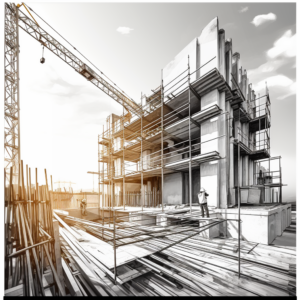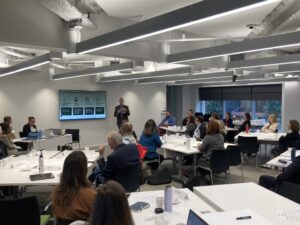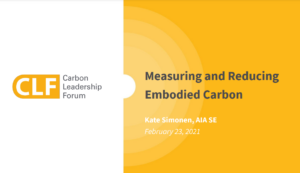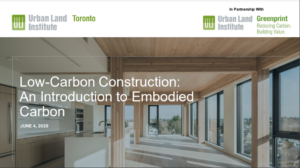Embodied Carbon
As much as 50% of the lifetime carbon emissions of our buildings come from building materials and construction. To truly achieve net zero, the real estate industry will have to work with architects and engineers, the construction industry, and building material providers to better track and reduce the carbon associated with this half of our buildings’ greenhouse gas footprint. Global investors, regulators, and leading tenants are beginning to better understand the impact of embodied carbon on building lifecycle emissions and are starting to engage real estate to build lower embodied carbon buildings.
ULI’s embodied carbon work aims to bring together industry leaders from across the real estate value chain to identify and implement strategies to track and reduce embodied carbon in our shared supply chain. ULI works with the industry to develop and promote cost-effective strategies to reduce embodied carbon from building materials and introduce stakeholders to innovations in building materials and design and construction strategies that reduce embodied carbon. ULI’s goal is to get the entire building supply chain committed to achieving net zero embodied carbon in construction, and to help this supply chain accelerate its progress to net zero.
GET INVOLVED
- ULI is working on a resource around intervention points in the design process where embodied carbon reductions can be explored. If you have project examples of embodied carbon reduction that you would like to be considered for inclusion in this resource, please email [email protected].
- Next ULI Embodied Carbon Convening – June 2024. More information coming soon!
GET INFORMED
ULI Reports
The Materials Movement: Creating Value with Better Building Materials
In the realm of construction, every component matters—from the concrete foundations to the final brush of paint. With building materials responsible for nearly 11 percent of global carbon emissions and innumerable toxic chemicals, the choices building professionals make every day have a profound influence on human well-being, the climate, and global ecosystems. ULI’s new report provides an introduction for real estate owners, developers, and investors to understand why and how to integrate healthy, sustainable building materials to save carbon and achieve sustainability, health, and financial goals.
ULI’s second Embodied Carbon Convening brought together developers, construction, concrete, and steel supplier industries to debunk and discuss misconceptions around reducing embodied carbon, specifically regarding concrete and steel.
State of Green: Greenprint Performance Report, Volume 14
As one of the largest global collections of transparent, verifiable, and comprehensive data about the environmental performance of buildings, this report provides aggregate benchmarks for the real estate industry on carbon, energy, waste, and water, and shows that despite a dizzying mix of market and other forces, whole-building energy consumption and carbon emissions reduced from 2021–2022. This volume also includes embodied carbon data and project profiles for the first time.
The first ULI Executive Convening on Embodied Carbon launched the first of many convenings to build stronger partnerships across the industry enabling accelerated advancement on sustainability improvements and beyond. ULI brought together executives in the construction and developer fields to collaborate on the challenges and opportunities of reducing carbon emissions in development.
Embodied Carbon in Building Materials for Real Estate
This report prepares the real estate market for a low-carbon materials future, makes the business case for why real estate should pay attention, highlights smart steps to reduce embodied carbon, and showcases peers already addressing the issue.
External Resources
The Carbon Leadership Forum’s Embodied Carbon Toolkit for Building Owners
The Carbon Leadership Forum has created an array of resources to support action by owners to radically reduce embodied carbon. Tools include: Embodied Carbon 101, Guidance on Embodied Carbon Disclosure, Urban EC Reduction Checklist, Embodied Carbon Policy Map etc.
Building Transparency EC3 Resources
The EC3 tool resources documents provided in the menu bar to the left have been created by Building Transparency and/or the Carbon Leadership Forum at the University of Washington. They are designed to help construction project Owners, Architects, Engineers, Contractors and Materials Manufactures understand how the EC3 tool works, what it does and how they can each use it to specify, procure and incentivize low carbon construction materials.
Building Transparency ownersCAN
ownersCAN, a sister program/counterpart to materialsCAN, is a group of developers, users, and managers of buildings that are dedicated to measuring and reducing the embodied carbon of their projects. The group has been created to raise awareness and provide education on the importance of embodied carbon in the built environment, and share strategies and lessons learned to inspire others to follow.
RMI’s Driving Action on Embodied Carbon in Buildings
The report identifies eleven questions that continue to hold back action on embodied carbon, and answers these questions with concise text and illustrations, providing key takeaways and action items as well as providing in-depth resources to be explored.
RMI’s Reducing Embodied Carbon in Buildings
The report provides specific recommendations to help architects, contractors, building owners, engineers, and others to reduce embodied carbon significantly at little to no additional up-front cost, using strategies and materials available today. The report also points to next-generation solutions that could drive even greater reductions.
GET INSPIRED

The Materials Movement: Creating Value with Better Building Materials
Friday, December 1st, 2023
See the recording and slides here.

Demystifying Embodied Carbon:
What Real Estate Needs to Know
Tuesday, October 31st, 2023 in Los Angeles, CA at ULI’s Fall Meeting
See the presentation slides here.

ULI Embodied Carbon Convening (Developers, Construction, Materials Suppliers)
Tuesday, September 26st, 2023 in Washington, DC
See agenda here.

ULI Executive Convening (Developers and Construction)
Tuesday, January 17st, 2023 in Washington, DC
See agenda here.
See recording of debrief Webinar here.
2 021 ULI Virtual Spring Meeting—The Future of Building Materials: Embodied Carbon and Why It Matters
021 ULI Virtual Spring Meeting—The Future of Building Materials: Embodied Carbon and Why It Matters
Wednesday, May 12th, 2021
See the recording and slides here.
 ULI British Columbia: The Next Big Thing: Embodied Carbon in Real Estate
ULI British Columbia: The Next Big Thing: Embodied Carbon in Real Estate
Tuesday, February 23rd, 2021
See the recording and slides here.
 ULI Toronto: Low-Carbon Construction
ULI Toronto: Low-Carbon Construction
Thursday, June 4th, 2020
See the recording and slides here.